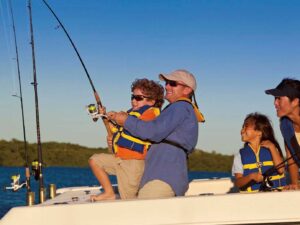
Your GPS and autopilot may steer you to a destination with preternatural accuracy. Your pod-driven, joystick-controlled cruiser may allow you to dock in a crosswind without benefit of experience. But so far as I know, technology has no point-and-click solution for tying a boat to a dock, an anchor chain to a line, or a towrope to your kid’s inflatable water toy. Is your marlinspike up to snuff?
If not, here are a few tips and terms that can help you out.
- Three key functions of good knots include ease of tying, ease of untying and holding power.
- A good knot to use for preventing line strands from unwinding at the cut end when heat and/or tape are unavailable is the figure of eight. It also serves as a great stopper knot.
- When it comes to knot tying, it’s helpful to know your terms. Some key words of note include bowline – pronounced “bo-lin” – and bight, which refers to a loop of line.
- Other key phrases to remember include “tailing a line,” which means to apply tension around a cleat, bitt, pole or other fixture without belaying, and “standing part,” which refers to the part of a line around which turns are taken with the running part in forming a knot.
- The purpose of a sheepshank knot is to shorten a line. This tidbit of knowledge can come in handy when shortening a line across a chafed spot.
- A clove hitch relies upon tension for its security and holding power. It is not an ideal knot for tying permanently to a piling, pole or spar.
- When constructing an anchor rode, a great knot to use when tying line to an anchor ring or shackel is the round turn and two half hitches, also known as the anchor bend or fisherman’s bend.
- A great knot for securing the standing part of a line tied to a tarp, cover or other item in which inducing maximum tension is desirable would be the trucker’s hitch.
- At a fixed dock in tidal waters, or wherever water levels fluctuate, it is best to have a cleat hitch at the working end of the line, that part that attaches to your cleat. A loop over a cleat can get too tight to undo if the line gets taut due to changing water levels.
- To stop your Bimini top’s support straps from buzzing in the wind underway, use a twist. Simply unclip the strap, put a twist in it, then reattach.
- To connect lines of different diameters securely together, for instance should the need to lengthen a dock or anchor line arise unexpectedly, use a sheet bend, also known as a becket hitch.
- When passing a loop through a cleat to tie-off, it is better to drape the loop over both horns of the cleat instead of just one because when you loop over just one horn, you stress the cleat fasteners more. Why rely on only half of the bolts to secure the cleat?
The U.S. Coast Guard is asking all boat owners and operators to help reduce fatalities, injuries, property damage, and associated healthcare costs related to recreational boating accidents by taking personal responsibility for their own safety and the safety of their passengers. Essential steps include: wearing a life jacket at all times and requiring passengers to do the same; never boating under the influence (BUI); successfully completing a boating safety course; and getting a Vessel Safety Check (VSC) annually from local U.S. Coast Guard Auxiliary, United States Power Squadrons(r), or your state boating agency’s Vessel Examiners. The U.S. Coast Guard reminds all boaters to “Boat Responsibly!” For more tips on boating safety, visit www.uscgboating.org.








